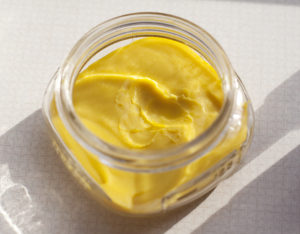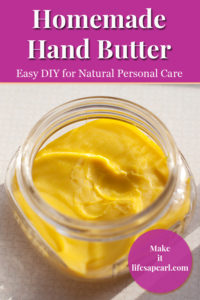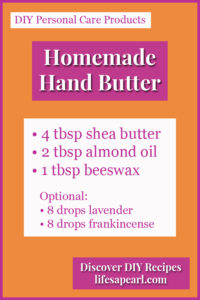Winter seems to be the hardest season on my hands. The cold weather often leaves my skin dry, at worst raw and chapped. It’s the time of year where I’m always reaching for a tube of hand lotion.
After certain lotions only seemed to irritate my skin more, I started making my own.
My mixture is more of a butter than a lotion. I find I have to apply it less with a smaller amount than store bought lotions. Sometimes only one time a day. Once it soaks in, it deeply moisturizes my hands.
Homemade Hand Butter

What You Will Need:
- 4 tbsp shea butter (I use raw unrefined)
- 2 tbsp almond oil
- 1 tbsp beeswax (I use pellets)
- 8 drops lavender essential oil (optional)
- 8 drops frankincense frereana essential oil (optional)
Why These Ingredients?
Shea butter is rich in fatty acids, antioxidants, and contains vitamins A and E to hydrate skin.
Almond oil is a light carrier oil, appropriate for all skin types. It softens and reconditions dry skin while spreading and soaking in easily.
Beeswax contains natural emulsifiers to help lock in moisture and heal dry and damaged skin.
Though optional, essential oils can be used to cover the sometimes potent earthy smell of shea butter. Lavender gives a calming scent and has both soothing and restorative properties for skin.
Frankincense frereana is known for it’s rejuvenating properties. It can smooth wrinkles and scars as well as promote the healing of dry or damaged skin.
How to Make Hand Butter:
You need a double boiler for this recipe. I don’t own one and often make do with a large glass measuring cup hooked over the edge of the pot and held above the boiling water or a glass bowl that is slightly too big to fit down inside the pot.
Using the double boiler, begin with melting the shea butter and beeswax over boiling water. Stir occasionally to combine.
Once the shea butter and beeswax are liquid, add the almond oil (already in liquid form) and mix together over low heat until combined.
Carefully, remove the measuring cup or bowl from the pot of water.
Let sit for about 10 minutes to cool down. If desired add in the drops of essential oil.
Pour the mixture into a glass container or jar. I usually use a 4 oz mason jar.
Allow the butter to solidify for at least 4 hours.
I use less than a dime sized amount on my hands. With this hand butter a little goes a long way. The butter will melt from your body heat as it spreads. Rub into hands until it’s soaked in.
I usually apply it right before bed so it has lots of time to absorb.
Use within 6 months.
Notes:
My homemade hand butter is very yellow because I use yellow beeswax pellets and yellow unrefined shea butter. Shea butter comes in a variety of shades from ivory to yellow so final product color will vary depending on which you use.
Shea butter can become gritty sometimes when cooled at room temperature. I haven’t experienced this yet, possibly since I make this recipe in the winter when our house is usually cold. One way to avoid the gritty texture is to cool the mixture quickly in the fridge or freezer.
Variations:
Cocoa butter or mango butter could be substituted for shea butter. Any carrier oil could be used instead of almond oil but I like it for it’s reconditioning benefits. Fractionated coconut oil, argan, avocado or jojoba oil would also be great choices.
If you enjoy experimenting with essential oils, you could add whatever you like to this base recipe. Other oils that are revitalizing and nourishing to dry skin include myrrh, cypress, carrot seed, lemon, chamomile, and fennel.
Other Recipes I Use These Ingredients For:
- I use both shea butter and beeswax in my diy lip balm.
- I add these essential oils to my basic homemade moisturizer and also combine them for an immune support diffuser blend.
- Lavender is one essential oil I use all the time, from my sleep aid roller bottle to my homemade shampoo recipe to my favorite diffuser blends for stress relief.
Resources:
6 Reasons to Make Your Own Personal Care Products
What are your favorite moisturizing recipes for winter? Do you use shea butter in your DIYs?



